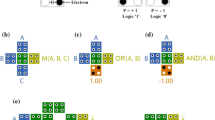Abstract
Complementary metal-oxide semiconductor (CMOS) technology may face so much problems in future due to the smaller size of transistors and increase in circuits’ volume and chips temperature. A new technology that can be a good alternative to CMOS circuits is quantum-dot cellular automata (QCA). These technologies have features such as a very low power consumption, high speed and small dimensions. In nano-communication system, error detection and correction in a receiver message are major factors. In addition, circuit reversibility in QCA helps designs a lot. In this research, generator and checker circuit of the reversible parity and eventually their nano-communication system are designed reversible using odd parity bit. The proposed circuits and the theoretical values are tested by QCADesigner 2.0.3 simulator to show the correct operation of the circuits. According to the simulation results, the proposed circuits compared with the previous structure improve delay by 90–75–35% in generator and checker structures of parity and their reversibility of nano-communication system, respectively. The proposed circuits are used in nano-transmitters and nano-receivers.













Similar content being viewed by others
References
Asfestani, M.N., Heikalabad, S.R.: A novel multiplexer-based structure for random access memory cell in quantum-dot cellular automata. Phys. B Condens. Matter 521, 162–167 (2017)
Das, J.C., De, D.: Circuit switching with quantum-dot cellular automata. Nano Commun. Netw. (2017). https://doi.org/10.1016/j.nancom.2017.09.002
Sen, B., Sahu, Y., Mukherjee, R., Nath, R.K., Sikdar, B.K.: On the reliability of majority logic structure in quantum-dot cellular automata. Microelectron. J. 47, 7–18 (2016)
Hosseinzadeh, H., Heikalabad, S.R.: A novel fault tolerant majority gate in quantum-dot cellular automata to create a revolution in design of fault tolerant nanostructures, with physical verification. Microelectron. Eng. 192, 52–60 (2018). https://doi.org/10.1016/j.mee.2018.01.019
Heikalabad, S.R., Navin, A.H., Hosseinzadeh, M.: Midpoint memory: a special memory structure for data-oriented models implementation. J. Circuits Syst. Comput. 24(5), 1550063 (2015)
Heikalabad, S.R., Navin, A.H., Hosseinzadeh, M.: Content addressable memory cell in quantum-dot cellular automata. Microelectron. Eng. 163, 140–150 (2016)
Tougaw, P.D., Lent, C.S.: Logical devices implemented using quantum cellular automata. J. Appl. Phys. 75(3), 1818–1825 (1994)
Tougaw, P.D.: A device architecture for computing with quantum dots. Proc. IEEE 85(4), 541–557 (1997)
Karkaj, E.T., Heikalabad, S.R.: Binary to gray and gray to binary converter in quantum-dot cellular automata. Opt. Int. J. Light Electron Opt. 130, 981–989 (2017). https://doi.org/10.1016/j.ijleo.2016.11.087
Karkaj, E.T., Heikalabad, S.R.: A testable parity conservative gate in quantum-dot cellular automata. Superlattices Microstruct. (2016). https://doi.org/10.1016/j.spmi.2016.08.054
Gadim, M.R., Navimipour, N.J.: A new three-level fault tolerance arithmetic and logic unit based on quantum dot cellular automata. Microsyst. Technol. (2017). https://doi.org/10.1007/s00542-017-3502-x
Heikalabad, S.R., Asfestani, M.N., Hosseinzadeh, M.: A full adder structure without crosswiring in quantum-dot cellular automata with energy dissipation analysis. J. Supercomput. (2017). https://doi.org/10.1007/s11227-017-2206-4
Barughi, Y.Z., Heikalabad, S.R.: A three-layer full adder/subtractor structure in quantum-dot cellular automata. Int. J. Theor. Phys. 56, 2848 (2017). https://doi.org/10.1007/s10773-017-3453-0
Rad, S.K., Heikalabad, S.R.: Reversible flip-flops in quantum-dot cellular automata. Int. J. Theor. Phys. 56, 2990 (2017). https://doi.org/10.1007/s10773-017-3466-8
Sadoghifar, A., Heikalabad, S.R.: A content-addressable memory structure using quantum cells in nanotechnology with energy dissipation analysis. Phys. B Condens. Matter 537, 202–206 (2018). https://doi.org/10.1016/j.physb.2018.02.024
Asfestani, M.N., Heikalabad, S.R.: A unique structure for the multiplexer in quantum dot cellular automata to create a revolution. Physica B Condens. Matter 512, 91–99 (2017). https://doi.org/10.1016/j.physb.2017.02.028
Babaie, S., Sadoghifar, A., Bahar, A.N.: Design of an efficient multilayer arithmetic logic unit in quantum-dot cellular automata (QCA). IEEE Trans. Circuits Syst. II Express Briefs (2018)
Salimzadeh, F., Heikalabad, S.R.: Design of a novel reversible structure for full adder/subtractor in quantum-dot cellular automata. Physica B Phys. Condens. Matter (2018). https://doi.org/10.1016/j.physb.2018.12.028
Heikalabad, S.R., Gadim, M.R.: Design of improved arithmetic logic unit in quantum-dot cellular automata. Int. J. Theor. Phys. 57(6), 1733–1747 (2018). https://doi.org/10.1007/s10773-018-3699-1
Kamrani, S., Heikalabad, S.R.: A unique reversible gate in quantum-dot cellular automata for implementation of four flip-flops without garbage outputs. Int. J. Theor. Phys. 57(11), 3340–3358 (2018). https://doi.org/10.1007/s10773-018-3847-7
Ahmadpour, S.S., Mosleh, M., Heikalabad, S.R.: A revolution in nanostructure designs by proposing a novel QCA full-adder based on optimized 3-input XOR. Physica B 550, 383–392 (2018). https://doi.org/10.1016/j.physb.2018.09.029
Sheikhfaal, S., Angizi, S., Sarmadi, S., Moaiyeri, M.H., Sayedsalehi, S.: Designing efficient QCA logical circuits with power dissipation analysis. Microelectron. J. 46(6), 462–471 (2015)
Silva, D.S., Sardinha, L.H.B., Vieira, M.A.M., Vieira, L.F.M., Vilela Neto, O.P.: Robust serial nanocommunication with QCA. IEEE Trans. Nanotechnol. 14(3), 464–472 (2015)
Das, J.C., De, D.: Quantum-dot cellular automata based reversible low power parity generator and parity checker design for nanocommunication. Front. Inf. Technol. Electron. Eng. 17(3), 224–236 (2016)
Ahmad, F., Bhat, G.M., Khademolhosseini, H., Azimi, S., Angizi, S., Navi, K.: Towards single layer quantum-dot cellular automata adders based on explicit interaction of cells. J. Comput. Sci. 16, 8–15 (2016)
Chabi, A.M., et al.: Towards ultra-efficient QCA reversible circuits. Microprocess. Microsyst. 49, 127–138 (2017)
Mano, M., Ciletti, M.D.: Digital Design, vol. 4. Prentice Hall, Upper Saddle River (2006)
Liu, W., Srivastava, S., Lu, L., Orneill, M., Swartzlander, E.E.: Are QCA cryptographic circuits resistant to power analysis attack? IEEE Trans. Nanotechnol. 11(6), 1239–1251 (2012)
Author information
Authors and Affiliations
Corresponding author
Additional information
Publisher's Note
Springer Nature remains neutral with regard to jurisdictional claims in published maps and institutional affiliations.
Rights and permissions
About this article
Cite this article
Norouzi, A., Heikalabad, S.R. Design of reversible parity generator and checker for the implementation of nano-communication systems in quantum-dot cellular automata. Photon Netw Commun 38, 231–243 (2019). https://doi.org/10.1007/s11107-019-00850-2
Received:
Accepted:
Published:
Issue Date:
DOI: https://doi.org/10.1007/s11107-019-00850-2




